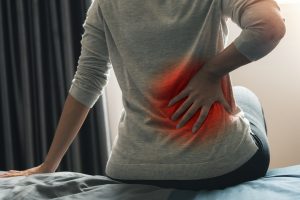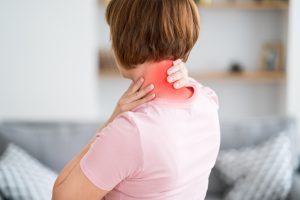Bulging Disc
If you have been diagnosed with a bulging disc, you are not alone. Bulging discs are also known as disc protrusions and are a very common occurrence in people of all ages. The spine is made up of small, round bones (vertebrae) that are cushioned by shock-absorbing discs that feature a tough, fibrous shell and a soft, gel-like core. The outer fibrous portion of our discs can weaken due to factors such as daily wear and tear, sudden injury, and the body’s natural aging process. Pressure from the inner core of the disc can then stretch to the outer rim, causing the disc to “bulge” outward in one direction.
If left untreated, the bulging disc can continue to stretch until it tears, which is classified as a herniated disc. Both bulging and herniated discs usually remain asymptomatic, however, they can cause discomfort and disability in various parts of the body if the disc compresses an adjacent nerve root or the spinal cord.
Causes of Bulging Discs
Understanding the causes of bulging discs can help you avoid activities that may worsen your symptoms. A bulging disc occurs when the disc’s tough outer shell weakens, prompting its softcore to press against the shell and bulge outward. While there can be several causes for a bulging disc, this weakening is often related to age. As we grow older, the spine’s discs and other components begin to lose water content and become increasingly brittle. While the natural aging process can’t be avoided, some activities and behaviors accelerate the spinal degeneration process and increase the risk of disc protrusion at a younger age. To help maintain good spinal health, consider:
- Losing excess weight
- Eating a balanced and nutrient-rich diet
- Quitting smoking and other forms of tobacco
- Keeping good posture
- Avoiding high impact sports and exercises
Additionally, be sure to protect your back when lifting, engage in low-impact exercise to strengthen core muscles and adopt a routine of gentle stretching. These behaviors can help keep your spine healthy and help you avoid bulging discs as you age.
Despite taking measures to maintain good spine health, bulging discs sometimes occur in otherwise healthy individuals. Several techniques may be used to confirm the presence of a bulging disc including X-ray imaging, a CT (computed tomography) scan, or an MRI (magnetic resonance imaging). Following the diagnosis of a symptomatic bulging disc, your physician will recommend treatments designed to relieve symptoms such as rest, exercises, and medication. Often symptoms arising from bulging discs can be effectively managed with these conservative treatments. If conservative treatment fails, however, your physician might recommend surgery to address the underlying cause of pain.
Treatment
Your ideal course of bulging disc treatment will vary according to the details of your diagnosis. For example, your symptoms and the specific location of the bulging disc in your spine will influence your treatment plan. However, generally speaking, a physician may first recommend a course of conservative approaches such as:
- Physical therapy – to strengthen and stretch the muscles that support the spine
- Nonsteroidal anti-inflammatory drugs (NSAIDs) – to provide temporary relief from pain and inflammation
- Gentle stretching exercises – to elongate the neck and back muscles and promote proper spinal alignment
- Alternating use of ice packs and heating pads – to numb pain, reduce inflammation, soothe tensed muscles, and improve circulation around the injured area
- Anti-inflammatory injections – provide temporary yet powerful relief from pain
- Lifestyle modifications – such as participating regulate low-impact exercise, buying more comfortable footwear, and wearing a brace to help maintain good posture.
Additionally, some bulging disc patients choose to explore alternative options such as yoga, chiropractic care, acupuncture, and herbal supplements. The long-term effectiveness of these methods varies for each patient’s condition, although some patients report positive results. The best way to determine the ideal bulging disc treatment plan for your needs is to speak with your doctor. Don’t be afraid to ask questions or voice any concerns you may have about your diagnosis or the treatment process.
Where Bulging Disc Can Occur
Bulging disc symptoms may vary according to the location of the injured disc in the spine. A high percentage of bulging discs occur in the lower back (lumbar area). The most common lumbar bulging disc is seen between lumbar vertebrae L4 and L5 and between vertebrae L5 and S1, causing pain in the L5 nerve or S1 spinal nerve, respectively. The sciatic nerve (the longest and largest nerve in the body) receives neurons from spinal nerve L3 to S3. If a bulging disc impinges upon one or more of these six spinal nerves, sciatic nerve pain could result. Sciatic pain originates in the lower back and radiates through the buttocks, down the back to the leg, and could extend to the foot.
The discs between the neck area, or cervical vertebrae, may also bulge. If nerve root compression occurs in the cervical or upper region of the spine, bulging disc symptoms will manifest in the neck with radiation to the scapular area, shoulder, arm, forearm, and hand.
Surgical Options
Many patients can find relief from bulging disc symptoms through a combination of conservative treatments and lifestyle modifications. Still, spinal surgery to relieve pressure on a compressed nerve or repair the bulging disc may sometimes be clinically appropriate after several weeks or months of conservative treatment that does not relieve severe symptoms.
While traditional open spine surgery involves long incisions, expensive hospitalization, significant surgical risk, and an extended, uncomfortable recovery period, minimally invasive alternatives address the underlying cause of pain through one or a few small incisions.
Symptoms
Because bulging disc does not always trigger obvious symptoms, many people have a bulging disc without realizing it. As long as the bulging portion of the disc does not press against a nearby nerve, no symptoms occur. If the bulging disc does cause a pinched nerve, you may begin to experience symptoms. Some of the most common bulging disc symptoms include:
- Pain that radiates through the arms and legs
- Localized pain around the area of the bulging disc
- Muscle weakness in the lower body
- Localized or radiating numbness and tingling sensations
- Neck stiffness
If you are concerned that your symptoms may be due to a bulging disc, you should consult a physician before diagnosis. Before your appointment, keep a log of your symptoms and how they respond to physical activity (or inactivity). This will help your physician determine the most appropriate diagnostic methods and treatment plan for your neck and back pain.
Minimally Invasive Surgery
BEST Health System’s approach to bulging disc treatment is unique. Our procedures require a less than one-inch incision and are performed on an outpatient basis. Many patients are up and walking within a few hours after surgery. When compared to traditional open spine operations, minimally invasive surgery at BEST Health System involves less risk and complication with shorter recovery periods.
Contact the dedicated team at BEST Health System today to learn more about our surgeons, world-class surgery centers, or our minimally invasive approach to bulging disc surgery.
Related Articles
Key Differences Between a Bulging Disc and a Disc Extrusion
Three Bulging Disc and Disc extrusion differences Although you may often hear the terms “bulging disc” and “disc extrusion” used interchangeably, it is important to […]
Bulging Disc - Traditional Surgeries
For patients who have exhausted conservative treatments for a bulging disc, the thought of disc surgery can be overwhelming and scary. Before you undergo any […]
Four Ways to Treat a Bulging Disc
Understanding Bulging Discs Living with a bulging disc can be inconvenient, but treatment for this condition doesn’t have to be. In fact, there are several […]
Can Obesity Cause a Bulging Disc?
What Causes a Bulging Disc? Excess body weight is one of the most common bulging disc causes. This is because the burden of carrying additional […]
Cervical Bulging Disc
What is a Cervical Bulging Disc? A cervical bulging disc describes the instance when a damaged disc in the cervical (upper) region of the spine […]
Diagnosing Back Pain
How is Back Pain Diagnosed? If you have back pain, it’s important to get a proper diagnosis prior to starting any treatment. Treating the wrong […]
Bulging Disc - Conservative Treatment
Have You Been Diagnosed with a Bulging Disc? As you begin to research treatments for a bulging disc, you should consult your physician or spine […]
Bulging Disc – How to Relieve Pain in the Neck?
A bulging disc in the neck can cause a variety of symptoms. These symptoms vary from patient to patient, even if the nerve root undergoing […]
Can Chiropractic Help Treat a Thoracic Bulging Disc?
Although the thoracic spine is the largest segment of the back, because of its relative stability it is also the least likely location for a […]
Can Extended Periods of Sitting Cause a Bulging Disc?
Many studies have shown that long periods of sitting can result in a number of adverse health effects, including an increased risk of heart disease, […]
Four Tips for Traveling by Car with a Bulging Disc
For patients coping with a bulging disc, prolonged sitting can be an ordeal, as it puts pressure on the muscles and discs of the spine, […]











